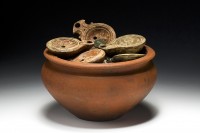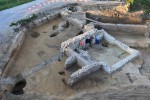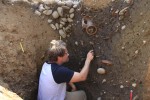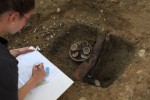 Archaeologists excavating the site of a Roman fort and civilian settlement in the northern Swiss city of Windisch have unearthed an unusual hoard: a cooking pot filled with lamps, each containing a single bronze coin. What is now the Zürcherstrasse, one of Windisch’s busiest streets, in the first century A.D. was the defensive wall of the Roman legionary camp of Vindonissa. It was established in the province of Germania Superior around 15 A.D. and was occupied by various legions until 101 A.D., after which it was integrated into the civilian settlement. The ancient town was inhabited through the 5th century.
Archaeologists excavating the site of a Roman fort and civilian settlement in the northern Swiss city of Windisch have unearthed an unusual hoard: a cooking pot filled with lamps, each containing a single bronze coin. What is now the Zürcherstrasse, one of Windisch’s busiest streets, in the first century A.D. was the defensive wall of the Roman legionary camp of Vindonissa. It was established in the province of Germania Superior around 15 A.D. and was occupied by various legions until 101 A.D., after which it was integrated into the civilian settlement. The ancient town was inhabited through the 5th century.
 The Aargau Canton archaeology department has been excavating the site south of Zürcherstrasse where a multi-use development with underground garage will be constructed, since 2013. They’ve discovered the remains of defensive earthworks, well-preserved stone buildings, fireplaces, a latrine pit and a deep brick shaft.
The Aargau Canton archaeology department has been excavating the site south of Zürcherstrasse where a multi-use development with underground garage will be constructed, since 2013. They’ve discovered the remains of defensive earthworks, well-preserved stone buildings, fireplaces, a latrine pit and a deep brick shaft.
 It was in the brick shaft that archaeologists found the pot, the kind of quotidian vessel the legionaries at Vindonissa would have used to cook their food, entirely intact and in exceptionally good condition. Inside were 22 oil lamps. They too were implements used by regular people in their daily life. They were filled with oil and lit at the spout end. Produced in enormous quantities and sold all over the empire, the lamps were often decorated on the top side with designs which would glow in the light. The lamps collected inside the pot are decorated with a variety of motifs: a flower, the moon goddess Luna, a winged Cupid, a defeated gladiator, a lion, a peacock, even an erotic scene.
It was in the brick shaft that archaeologists found the pot, the kind of quotidian vessel the legionaries at Vindonissa would have used to cook their food, entirely intact and in exceptionally good condition. Inside were 22 oil lamps. They too were implements used by regular people in their daily life. They were filled with oil and lit at the spout end. Produced in enormous quantities and sold all over the empire, the lamps were often decorated on the top side with designs which would glow in the light. The lamps collected inside the pot are decorated with a variety of motifs: a flower, the moon goddess Luna, a winged Cupid, a defeated gladiator, a lion, a peacock, even an erotic scene.
 An as, a bronze coin that was lowest value currency in the early Roman Empire, was placed inside each lamp. Almost all of the coins date to 66 and 67 A.D., a range that fits the style of the cooking pot and lamps. Because asses were of such low value, their inclusion in this odd assemblage is likely symbolic.
An as, a bronze coin that was lowest value currency in the early Roman Empire, was placed inside each lamp. Almost all of the coins date to 66 and 67 A.D., a range that fits the style of the cooking pot and lamps. Because asses were of such low value, their inclusion in this odd assemblage is likely symbolic.
“What astonished us was the quantity and the combination of coins and lamps,” said Aargau cantonal archaeologist Georg Matter.
“We suspect this is a ritual burial,” he said, but stressed that was only speculation since there haven’t been any other comparable discoveries.
The pot also contained charred fragments of animal bones, ruling it out as a urn for human remains.
“The intentions behind this burial are puzzling at the moment,” added Matter.
The pot has been fully excavated in the laboratory, the lamps catalogued and photographed. Next on the schedule is examination of the coins by numismatic experts and the analysis of the bone fragments.